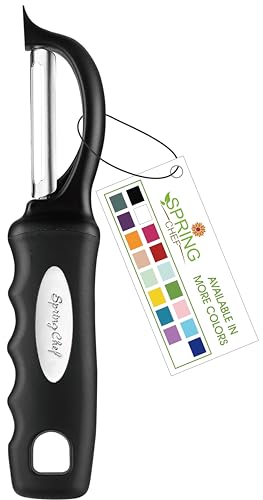Vegetable peelers are an essential tool for preparing and peeling vegetables or fruits. Choosing the right one can save you a lot of hassle when cooking or garnishing food. Here's a comprehensive guide to help you choose the right peeler.
Sharpness
A sharp blade is essential for efficiently peeling vegetables, and it should retain its sharpness over time with minimal maintenance and care. Look for blades made of high-quality stainless steel, which will hold their sharp edge longer than other materials. Check out the reviews to know how well the blade performs in terms of sharpness and how frequently you might need to sharpen it.
Handle Design and Grip
Next, think about the handle design of your next vegetable peeler. Comfort and control are key to getting good results without causing strain on your hand or wrist. An ergonomically designed handle with a non-slip grip provides maximum comfort and control while peeling.
Ease of Use and Safety Features
Safety is also essential when working with sharp tools, so try to find one with features such as a protective guard to protect your hands from accidental cuts. Look out for models with a swivel head or a built-in finger guard to further protect your fingers while working.
Size
Depending on what type of vegetables you plan on peeling, size may be essential when finding your perfect vegetable peeler. If you're typically dealing with smaller items like carrots or potatoes, a short blade may work fine. But if you're looking to strip ribbons or quickly peel larger items like cucumbers, opt for something longer, such as an 8-inch blade or even a 12-inch model if available.
Weight
As you scroll through product pages, be sure to check the weight of each peeler before making your purchase decision. Although lightweight models might be easier to handle and store, they may not be as sturdy as heavier models, which provide more stability during use. If you plan on having long peeling sessions in the kitchen, then a few extra ounces could be worth the trade-off in terms of comfort and longevity.
Rust Resistance
Stainless steel models are less likely to rust over time than other materials, so this would be an important feature if you frequently use your peeler in wet environments, such as near a sink or outdoors.
Dishwasher Safe
Another convenient feature would be a model that's easy to clean. Look out for a dishwasher-safe model to make hygiene management more convenient for you.
Material
Vegetable peelers are typically made from either stainless steel or plastic material, so this is something else to consider before finalizing your purchase decision. Remember that plastic models tend to wear down faster than stainless steel alternatives over time and may require more frequent replacements due to their inferior quality compared to their metal counterparts.
Price
Price is always a factor, so check various websites and stores for prices before jumping into anything too quickly. Cheaper can sometimes come at the cost of performance, especially for kitchen tools. Determine the type of budget you’re working within before making any decisions.
Warranty
A warranty helps guarantee peace of mind regarding product support should anything go awry during its use. Plus, most warranties also cover any manufacturer defects found at the time of delivery to make your purchase safer.
Durability
The vegetable peeler you choose should also have good build quality overall, reassuring that it won't break apart easily after extended periods of leverage & pressure while operating. Make sure to inspect these levels before making a purchase commitment.
Ability to Strip Ribbons or Produce Julienne Cuts
Another feature to consider is whether it can produce julienne cuts or ribbons, which might be useful. The Y-shaped varieties generally work best here due to their two-blade combination being able to slice more finely and accurately while offering greater leverage in peeling complex vegetables.
Number of Blades
Finally, consider the number of blades since some models come with dual blades, which allows easier transition between the thickest and thinnest peels, respectively. This could save plenty of time, especially for those who use it frequently. However, more blades usually mean a higher price tag. Consider the price point and the features important to you and choose accordingly.





